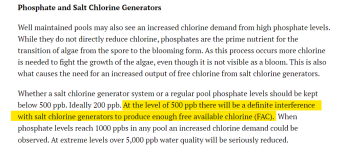- May 3, 2007
- 18,073
- Pool Size
- 20000
- Surface
- Plaster
- Chlorine
- Salt Water Generator
- SWG Type
- Hayward Aqua Rite (T-15)
This is an article in a trade magazine and not a scientific research paper so the author is really under no obligation to support any claims. Most of the internet is made up of various claims, some plausible, some dubious and most totally ridiculous. However, I do agree that if they wanted to be taken seriously, they should have provided more supporting evidence. But the article is not completely devoid of supporting evidence either:The person making a claim has to provide the support for their claim.
The use of orthophosphates in water distribution systems is fairly well documented so I think that part is relevant.A product known as zinc orthophosphate is used in drinking water systems because it adheres to metal pipes and acts as an anti-corrosion agent. So, from this we know that orthophosphate likes to cling to metals. The real interference of phosphates in chlorine generators is still somewhat theoretical. It appears that since orthophosphates attach to metals they attach to the anode and cause an interference with the flow of electrons between the anode and the cathode of the salt chlorine generator. We do know that higher levels of orthophosphate seem to cause a definite interference with the normal operation of the salt chlorine generators.

Why do water systems add phosphate to drinking water? What are the health effects of drinking water containing phosphates? | US EPA
Why do water systems add phosphate to drinking water? What are the health effects of drinking water containing phosphates?
Also, the above articles explain that the protection that orthophosphate supplies to pipes, besides sequestering, is really a form of mineral scale and we do know that scale inhibits the electrolytic reaction. We also know that scale comes in several flavors including calcium carbonate and calcium phosphate both of which are possible in swimming pools and most likely SWGs as well.

Understanding Calcium Carbonate Scale
Calcium carbonate scale is a result of water being oversaturated with calcium carbonate, as measured on the LSI. Learn more about other types of scale too.
.png) blog.orendatech.com
blog.orendatech.com
Chem Geek was mentioned:
Given the PH near the SWG plates is higher than in the body water and using a higher CH level of 600 ppm, pH 8, and a water temp of 100F, conditions one might find in a spa, the PO4 required drops to 4.2 ppm, a little lower than what my pool experienced. Also, the Orinda article mentions that calcium phosphate is harder than calcium carbonate:Thanks to renowned water chemist Richard Falk, here is the formula for how much phosphate you need in your water in order to precipitate calcium phosphate scale:
PO4 = 10^[11.755 - log(CaH) - 2log(t) - (0.65 * pH)]
The temperature "t" is in Celsius.
So for 375 ppm CH, 7.5 pH and 80ºF (26.67ºC) we have
10^[11.755 - log(375) - 2log(26.67) - (0.65 * 7.5)] = 28.44 ppm = 28,440 ppb phosphate
On the Moh's 1-10 scale of mineral hardness, calcium phosphate is a 5, whereas calcium carbonate is just a 3. If you have calcium phosphate scale, it can be extremely difficult to remove and sometimes justifies replacing equipment entirely.
So it seems plausible to me that there could be a direct relationship.






